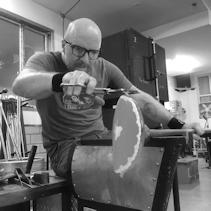
Steve Hagan is a glass artist, foodie, and proponent of pure beauty. His works combine a love of function with modern form and design, while often creating a mix of citrus inspired jewelry, tableware, and sculpture. A Philadelphia native, Steve attended Tyler School of Art where he was first able to witness the fluid and spontaneous nature of glass. Graduating in 2002 from Temple University he spent the next few years invested in the public access glass scene of Philadelphia teaching at multiple area studios. In 2008, he re-entered academia and began his graduate studies at Southern Illinois University Carbondale. His thesis exhibition titled “the apple doesn’t fall far from the tree” in 2011 opened up a more sculptural approach to his studio practice, combining both extensive murrini pattern applications and non-vessel glass blowing. Since that time, he has lived all around the US while traveling to make his work through residencies and as a visiting artist. Currently residing in Tucson, he runs a private glass studio with Mark Leputa where they have a warm, flame, and cold shop while utilizing Sonoran Glass School’s public access hot shop for their glassblowing applications.
“Citrus fruits are bright, aromatic, and a sensory explosion. Whether an addition to food or drink, I love the variety and ability for citrus to overwhelm our senses. The smells, flavors, and colors are expansive. Raised in a culinary family, I began my love affair with food at a young age. Learning that time spent in the kitchen often was a fun and rewarding usage of my creative energy. When I was first exposed to glass making, it completely overwhelmed me by the fluidity and dance that occurs with the material. Now 25+ years later I have combined my two true loves…. Food and glass. Utilizing a combination of traditional and nontraditional glass cane and murrini techniques I create larger than life fruit sculptures with vibrant colors and intricate details. Each sculpture pattern is painstakingly constructed to resemble the interior structure of citrus. The pith and vesicles are represented by alternating veil and filigrana patterning techniques with color variations.
Each citrus fruit sculpture utilizes all of my glass experience. The development of techniques through trial and error occurred on a smaller scale initially with the techniques used to create life sized lemons. Now the sculptures are larger than life, allowing the viewer to dive deeper into the developed details of each citrus fruit. I layer patterning techniques with surface carving to really enhance the depth of each fruit slice or wedge.”